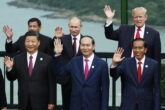July 13, 2022
NATO’s Madrid Summit: A missed opportunity for European strategic responsibility
On June 29 and 30, 2022, NATO Heads of State and Government met in Madrid for a highly anticipated summit. This gathering offered an occasion to define an innovative vision for the future of the alliance, which has gained renewed relevance in the context of Russia’s ongoing war against Ukraine. While the summit did yield some important achievements, most notably a diplomatic breakthrough that clears the path to membership for Finland and Sweden, it nonetheless failed to meaningfully advance what should be one of NATO’s foremost priorities — building a stronger European pillar in the alliance.
Greater European strategic responsibility is vital for the future of NATO. While tensions around unequal burden-sharing are a long-standing element of the transatlantic relationship, recent years have highlighted the urgent problems that the status quo poses to both the United States and Europe. Washington increasingly focuses on both domestic issues and the challenges posed by China in the Indo-Pacific. This shift in priorities casts doubt on the sustainability of massive military commitments to Europe. European leaders at both the national and E.U. levels, meanwhile, have stressed that Europe needs greater strategic autonomy to become a stronger geopolitical actor in a more turbulent international environment.
Europeans must commit to higher defense spending and use the full potential of the European Union to better coordinate their investments.
Although shared interest in rebalancing NATO presents a window of opportunity to work toward greater European strategic responsibility, achieving this goal will require bold decision-making. To build the necessary capabilities to assume a greater share of the burden for defense and deterrence, Europeans must commit to higher defense spending and use the full potential of the European Union to better coordinate their investments.
However, Europe’s success in addressing these dual “free-rider” and “collective-action” problems, as the Atlantic Council’s Emma Ashford recently labeled them, depends in large part on the actions of others. On the one hand, NATO member states are unlikely to increase their defense spending as long as the United States continues to provide the vast majority of capabilities on the European continent. On the other hand, the European Union’s ability to integrate European defense by reducing fragmentation will be limited unless the supranational bloc is fully embraced by NATO as the emerging political center of gravity in Europe. This trend is only likely to accelerate given the constellation of avidly pro-integration governments currently in power in leading member states such as France, Germany, and Italy.
Read the full article from Georgetown University's Institute for the Study of Diplomacy.
More from CNAS
-
A New Era of Strongman Rulers Is Upon Us
The consequences of strongman rule also seep into the fabric of economies and everyday life....
By Andrea Kendall-Taylor
-
Did Europe Change Trump's Mind on Ukraine?
The Trump administration made a major move this week in its announcement of sanctions on major Russian oil companies Rosneft and Luke Oil, along with 31 subsidiaries. This fol...
By Andrea Kendall-Taylor & Jim Townsend
-
Transatlantic Security / Energy, Economics & Security
Bloomberg Tech | Day 1 | Opening Night DebateGeoffrey Gertz, senior fellow, joined Bloomberg Tech's opening night debate and attempted to answer the question “Is Europe Too Late to Compete in the Chip War?” The U.S. and ...
By Geoffrey Gertz
-
A Tale of Two Russias: Views from Former Intelligence Officers
Four years into its war in Ukraine, Russia continues to escalate attacks on the Ukrainian population while also dialing up its hybrid campaign against Europe. In the last six ...
By Andrea Kendall-Taylor, Jim Townsend & Peter Schroeder




